
By Peter Cummins, Special Correspondent, Pattaya
Mail
Photos: Courtesy of the Bureau of the Royal Household
Prologue
It is very difficult to encapsulate the incredible achievements of our
beloved King in this short article. The writer, rather, has highlighted just
some of the events, honours and accolades which have been dedicated to His
Majesty, particularly in this auspicious year of his 82nd birthday.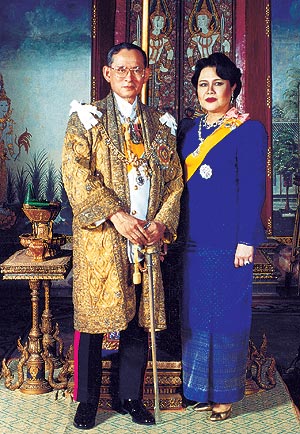
Born on Monday, the fifth of December, 1927 at the Mount Auburn Hospital,
Cambridge, Massachusetts, HM King Bhumibol Adulyadej the Great reaches his
eighty-first birthday just two years after celebrating sixty years on the
Thai Throne.
As the Thai people - and, in fact, people all around the world - honour this
year’s anniversary of the birth of the world’s longest-reigning Monarch, the
Pattaya Mail presents this supplement, prepared by special correspondent
Peter Cummins, as a “Happy Birthday” tribute to our beloved King.
In his Coronation Oath, promulgated on the fifth of May 1950, the
newly-crowned King Rama the Ninth vowed that, “We will reign with
righteousness for the benefit and happiness of the Siamese people” and in
all the years which have passed since that auspicious day, the concept of
“righteousness” has dominated his reign. In fact, HM the King has,
throughout his more than six decades of rule, constantly revered the age-old
Buddhist concept of ‘Kingship’ as defined in the “Sutta Pitaka” of the
“Tripitaka” in which a King is defined as “Mahasammata” - a King of
Righteousness. The Buddhist scriptures also define the genesis of the
universe and the progression of evils which befall mankind: greed, stealing
and lying and the inevitable repercussions of censure and punishment.
Our King has steadfastly reigned by these principles, embodying good
kingship in his own life and example and often speaking out against the
affliction of the evils so clearly spelled out in the Buddhist philosophy -
evils and afflictions which seem to have become progressively worse in the
past tumultuous years.
There will inevitably be some familiar material in parts of this story, for
HM the King’s development projects have been ongoing for more than 50 years
and there is, of course, a historical perspective which has been
incorporated.
Accession to the Thai Throne
His Majesty the King was pronounced successor to the throne in
June 1946. After four years of studying in Europe, he returned to Thailand
and was crowned during an elaborate and highly intricate ceremony.
 King
Bhumibol Adulyadej’s
King
Bhumibol Adulyadej’s
coronation, 5 May 1950
On April 28, 1950, a week before his coronation, H.M. King Bhumibol and Mom
Rajawongse Sirikit Kitayakara were married. Following the coronation HM the
King returned to Switzerland to continue studying.
The Coronation Ceremony reinforces the stature of the Kings of Thailand. The
first such elaborate ceremony was performed when Pho Khun Phamuang succeeded
Pho Khun Bangklangthao as the ruling King of Muang Sukhothai. Phaya Lithai,
a former leader in Sukhothai, left a historical record in stone describing
the coronation ceremony in Sukhothai at Wat Srikhum.
In the beginning of the Ratanakosin era, the first King in the Chakri
Dynasty (King Buddha Yot Fa Chulalokmaharach) took the title of Rama I and
moved the capital of Siam from Thonburi to the opposite bank of the Chao
Phraya River, and constructed Krung Ratanakosin (Bangkok). In the process of
building the Royal Palace and Wat Prakaew (Temple of the Emerald Buddha),
the first King in the House of Chakri refined the coronation ceremony,
establishing important protocol that has lasted to this day.
The annual commemoration of the coronation ceremony is a three-day affair,
starting with a ritual “tham bun” ceremony on May 3 to honour the King’s
ancestors. Later on the first day, another ceremony is performed, whereby
flags of honour are issued to distinguish various military units.
The following day, Buddhist ceremonies continue with chanting rituals,
prayers and Brahman priests announce the auspicious occasion of the next day
(May 5).
On May 5, His Majesty King Bhumibol Adulyadej the Great (Rama IX) conducts a
merit-making ceremony, presenting offerings to Buddhist monks, and leads a
“Wien Thien” ceremony, walking three times around the sacred grounds at the
Temple of the Emerald Buddha.
In the evening HM the King conducts another sacred ceremony: changing the
yellow cloth on the Emerald Buddha, the guardian symbol protecting the Thai
people, which was transferred from Thonburi to Wat Phra Kaew by King Rama I.
Many rooms in the Royal Palace are opened for public viewing on Coronation
Day. Auspicious ceremonies are performed and displays depicting royal
achievements are exhibited to reconfirm the King’s stature.
King Bhumibol Adulyadej: Ever Attentive to
Royal Duties
His Majesty the King continued to have many official duties over
the past years, culminating in an abundance of official functions two years
ago to commemorate his Diamond Jubilee on the Thai Throne, continuing right
through to this year, up to his 82nd birthday.
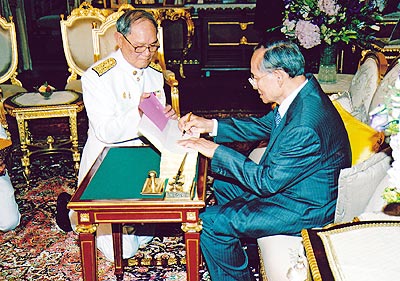
On August 24, 2007, His Majesty the King put his
signature on the 2007
Constitution at Chitralada Throne, Dusit Royal Palace.
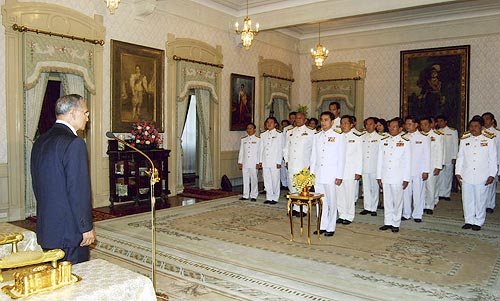
HM King Bhumibol Adulyadej calls for the new
government to make peace its priority during a swearing-in ceremony at
Chitralada Palace in Bangkok Monday, Dec. 22, 2008. Prime Minister Abhisit
Vejjajiva, standing front row, and his cabinet members listen intently.
One of his many functions during this period was to open the new Rama VIII
Bridge - the 475-metre long cable-stay bridge which the King had planned
since July 1996, having it constructed to commemorate King Ananda Mahidol,
Rama the Eighth.
HM King Bhumibol introduced a number of aesthetic designs based upon the
former King’s royal seal. As in all of His ideas, the new bridge was
designed and built to have the least possible effect on the fragile
environment of the Chao Phraya River, the riverbanks and the surrounding
river approaches.
After the official opening, the City of Bangkok presented His Majesty with a
24K gold model of the bridge, and a gold plate with the bridge engraved upon
it to HRH Princess Maha Chakri Sirindhorn who accompanied HM the King at the
opening.

In August 2007, His Majesty the King granted an
audience to Apisak Tantiworawong,
chairman of the joint three private sectors committee and chairman of Thai
Military Bank,
along with accompanying members, to present the Chai Pattana water turbine
to HM the King to celebrate his 60th year on throne.
Development Centres
Over the years, the King has established five Royal Development
Study Centres - or, as they are better known - “Living Museums” - situated
in the roughest terrain in their respective regions. These centres are the
locale for experiments in re-forestation, irrigation, land development and
farm technology which are conducted to find practical applications within
the constraints of local conditions, geography and topography. His Majesty’s
aim is to restore the natural balance, to enable people to become
self-supporting.
The first centre organized was that of Khao Hin Son, in the rocky area of
Chachoengsao’s Phanom Sarakam District. Here, the centre studies how to turn
the barren soil, caused by de-forestation, back into fertile land again.
Other centres are located at strategic places around the Kingdom. The Pikul
Thong Centre at Narathiwat studies the swampy, acidic land of the
southern-most region.
The Phu Phan Centre in Sakhon Nakhon studies soil salinization and
irrigation in the country’s biggest region, the Northeast which suffers from
endemic drought.
The Krung Kraben Bay Centre in Chantaburi examines the rehabilitation of
mangrove forests and coastal areas following massive destruction.
The Huay Sai Centre in Petchaburi studies the rehabilitation of degraded
forests and shows villagers, in their turn, how to protect the forests.
When he is in doubt, HM the King will fly over a particular area, armed with
aerial photographs and maps of the terrain, noting features as they pass
underneath. But, being a good photographer himself, he also takes his own
pictures and later juxtaposes them over the charts to obtain a detailed
image of the area of his concern which helps in his planning of specific
development projects.
Throughout the more than six decades that HM the King has ruled Thailand,
not only Thais, but people around the world have become accustomed to seeing
His Majesty travelling to remote areas of the country. He works with - and
brings rational development to - even the poorest and most disadvantage
groups. He is often filmed leading officials, farmers and many diverse
groups up rough mountain trails, over bridges, punting along in small
sampans, to initiate sustainable projects and ideas, aimed at helping the
many who have been forgotten or left behind in the development process.
His Majesty’s insightful approach to local prevailing conditions has enabled
him to improvise new theories for agricultural development, to provide
guidelines for educating farmers on self-sufficiency, and to solve problems
of goitre by feeding iodine into salt roads at strategic points.
In all these works, His Majesty has promoted a simple approach using
environmentally-friendly techniques and utilizing moderate amounts of
locally available resources. For example, before environmentalism became a
major force in the development equation, His Majesty was using vetiver grass
to prevent erosion, controlling ground water level to reduce soil acidity,
and seeding clouds with simple materials such as dry ice to produce rain.
HM the King’s Philosophy
His Majesty the King has stated his opinion on countless matters
over the years. These royal words of wisdom reflect his great sensitivity to
the needs of his people and their problems and his down-to-earth approach to
problem-solving.
Herewith are some excerpts on His Majesty’s ideals:
I shall reign with righteousness for the happiness and benefit of the
Siamese people, was his promise 60 years ago.
To achieve desired results that are also beneficial and morally just, you
need more than just knowledge: You need honesty, sincerity, and justice.
Knowledge is like an engine that propels a vehicle. Moral principles are the
steering wheel or rudder that leads the vehicle safely in the right
direction.
Knowledge helps you to understand religion on a broad basis; religion helps
you understand knowledge in depth. Therefore knowledge and religion have to
go hand-in-hand; they are both essential to life. Whoever possesses both
knowledge and religion shall achieve success in life without fail, because
they can analyse everything in detail and a rational way.
Academic subjects that you are constantly being tested for, do not alone
account for your survival and will not create benefit for yourself, for
others, or for the country. Those with knowledge also need other additional
qualifications to bring themselves and the nation to survival and
prosperity.
The necessary qualifications are a tender conscience, honesty in thought and
deed, loyalty to the nation and your patrons, selflessness and not taking
advantage of others, sincerity and meaning well to others, generosity as
benefiting your status and position, and most importantly, perseverance.
Practice doing projects on your own both big and small, simple and
complicated, with determination, without sloth, carelessness, or vulgarity.

When you want to study anything in depth, you have to study it from every
conceivable angle, not only in part, or become fixated on a particular
aspect. Secondly, what you must also do is consider the subject with an
unbiased and unwavering heart. Do not let the dark influence of prejudice
misguide you, whether it is prejudice in favour of, or against, the matter.
Otherwise, the knowledge which is gained will not be true knowledge, but
knowledge that is a mere illusion, or misleading. It cannot be applied to
create benefit without incurring negative results.
When you have clearly analysed the issue with a heart that is unbiased, then
only will true understanding arise, leading to a just decision and action.
You must set your mind to be objective, not allowing any prejudice to
prevail. Let your heart be led by truth and justice, based on reason and
morality.
Knowledge, intelligence, and efficient equipment, alone cannot help us
create total prosperity and stability for the country. To do so we need one
other element, that is unity, or cooperation, so that we can use that
knowledge, intellect and equipment to create true prosperity as desired.

His Majesty the King graciously presided over
the rededication ceremonies
of the renovated Giant Swing in front of City Hall in Bangkok on September
12, 2007.

HM King Bhumibol Adulyadej lights candles on His
lotus shaped krathong watched
by Her Majesty the Queen and HRH Prince Vajiralongkorn during the Loy
Krathong festival a
t Siriraj Hospital in Bangkok on November 2, 2009.

On April 30, 2007, in honor of his 80th birthday
anniversary His Majesty the King graciously
presided over the releasing ceremony for the Coast Guard patrol ship
at the shipyard department in Bangkok Noi.
Accolades Pour In
The King has been named an ‘Asian Hero’ among 65 prominent
figures designated by Time Magazine as “Asian Heroes”.
“The King’s stewardship has been so masterful that in times of crisis, Thais
invariably turn to one man: (HM) King Bhumibol,” writes the article
published in the magazine’s Nov 13, 2006 issue.
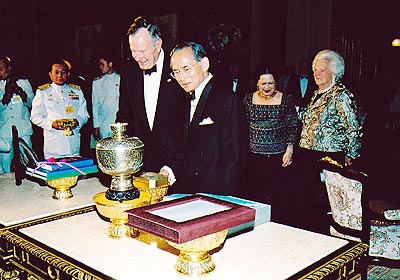
On December 11, 2006, His Majesty the King
hosted a dinner reception at the Chakri Throne in the Royal Palace for
visiting former US president, Gorge Bush and his wife, on the occasion of
their visit to Thailand as guests of honor representing the US President to
pay their respects to HM the King on the 60th anniversary of his ascension
to the throne.
“On two occasions - October 1973 and May 1992 - with Thailand descending
into chaos, (HM) the King, armed only with his moral authority, intervened
to end blood-shed,” it said.
Elsewhere, His Majesty has been named the first recipient of the Norman E
Borlaug World Food Prize Medallion in recognition of His Majesty’s
outstanding humanitarian service in alleviating starvation and poverty,
presented by the World Food Prize Foundation on July 23, 2007.
The award, introduced for the first time last year as a special
commemoration of the World Food Prize’s 21st anniversary, is a special
honour for individuals who have provided exceptional humanitarian service in
reducing hunger and poverty.
The medallion is named in honour of the World Food Prize founder and Nobel
Peace Prize Laureate Dr Norman Borlaug.

On November 23, 2007, His Majesty the King
granted an audience to Akrathorn Chularat, Chief Judge of the Supreme
Administrative Court, and the directing committee of the Association of
International Supreme Administrative Courts, their management, and chief
judges, at Chitralada Throne, Dusit Royal Palace, on HM the King’s 80th
birthday December 5, 2007.
“Since his accession to the throne in 1946, (HM) King Bhumibol Adulyadej has
displayed a deep concern that the Thai people have sufficient food and
proper nutrition,” said Ambassador Kenneth M Quinn, president of the World
Food Prize Foundation.
“His Majesty’s commitment to his subjects has been reflected in the more
than 2,000 royal projects he has established throughout the country, the
first of which was initiated in 1952,” he said.
The projects include efforts to promote small-scale agriculture, the
introduction of new agriculture technologies and the sustainable use of
water.
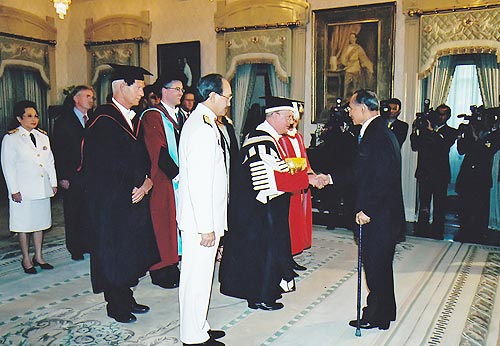
On February 21, 2007, His Majesty the King was
presented an honorary doctorate degree
in civil law by the former Vice-Chancellor of the University of Durham,
U.K.,
Sir Kenneth Calman, at the Chitrlada Throne, Dusit Royal Palace.
HM the King was also lauded by Kofi Anan, Secretary-General of the United
Nations, as the “Development King”, acknowledging his dedication to promote
child health, combat iodine deficiency and increase access to education. And
two years ago, His Majesty the King received the UNDP Human Development
Lifetime Achievement Award in recognition of the global relevance of his
call for a sufficiency approach to development, presented by United Nations
Development Programme on 26 May 2006.
The royal projects have benefited million of people across Thailand, with a
particular focus on aiding ethnic groups and hill tribes in mountainous
regions.
“Dr Borlaug tells of his visits to Thailand and the time he spent meeting
with His Majesty and walking through the countryside with him as they
discussed possible new approaches to agriculture,” said Mr Quinn.
A different type of honour was forthcoming when several hundred thousand
people took part in a walkathon on the new cable-stayed bridge, an event
organized by the Transport Ministry to mark His Majesty the King’s 60 years
on the throne.
The Republic of Korea’s Korea Invention Promotion Association, or KIPA, last
year presented a Special Prize in honour of His Majesty, who is recognized
as the “Father of Thai Invention.” This organization promotes intellectual
property and expands patent management support.
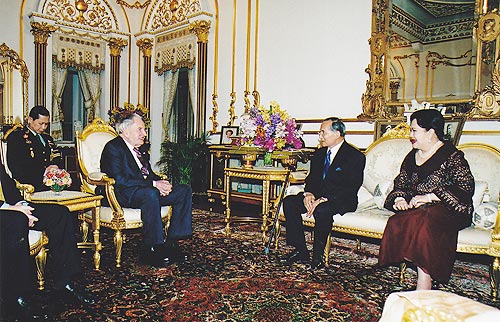
On February 8, 2007, His Majesty the King
granted an audience to David Rockefeller,
the honorary chairman of Rockefeller University and his guests at Chitrlada
Throne,
Dusit Royal Place during their visit to Thailand.
Most recently, the Budapest-based International Federation of Inventors’
Association (IFIA) presented the IFIA Cup 2007 for His Majesty’s Chai
Pattana wheel used to treat water. The IFIA also presented its Genius Medal
prize to honour His Majesty’s Self-Sufficiency Philosophy, and his New
Theory, which revives farming techniques based on Thai wisdom focusing on
minimal use of resources but aiming for higher agricultural productivity.
IFIA has decided to designate February 2 International Inventor’s Day in
honour of His Majesty the King, whose patent for the Chai Pattana Aerator
was granted on 2 February 1993 by the Department of Intellectual Property,
Ministry of Commerce of Thailand. Two years later, the Cabinet approved the
proclamation of February 2 each year as National Inventor’s Day, when
activities are organized to celebrate this event.
Thailand hosted the first International Inventor’s Day Convention from
February 2 to 5 2008, in commemoration of His Majesty the King’s 80th
Birthday Anniversary, 5 December 2007. His Majesty is the first member of
the Thai Royal Family to be granted a patent for an invention.

His Majesty the King waves to His joyful
subjects during the traditional Loy Krathong festival
as He is taken to the pier on the banks of the Chao Phraya River in Bangkok
to watch the procession of illuminated boats and to float His krathong,
Monday, Nov. 2, 2009.
Epilogue
As one would expect from a Monarch defined as “Mahasammata”, or a
“King of Righteousness”, by all the people and who, upon his accession to
the Throne in 1950, embraced the “Tenfold Moral principles of the
Sovereign”, His Majesty has ruled quietly and without ostentation.
Starting very early in his reign and continuing to this day, HM the King,
usually accompanied by HM the Queen and second daughter HRH Princess Maha
Chakri Sirindhorn, travelled to the far corners of the Kingdom to learn
first-hand from the farmers and peoples of the rural areas about their
problems.
Again, as with all his other interests, the Monarch studies, observes,
photographs and imbues himself with all the relevant knowledge and facts
that he needs to move forward with recommendations, implementation of
beneficial projects and follow-up.
The Thai Monarch is probably best known, universally, for his unbending
resolve to improve the lives of each and every one of his people - a
singular dedication to their welfare which has been acclaimed from all
corners of the world.
A lasting image of HM the King is that of a man, often kneeling or sitting
on the ground, poring over charts and topographical maps of the area, while
surrounded by local farmers and villagers discussing their problems.

Their Majesties the King and Queen attend
religious rites for the late H.R.H. Princess Galyani Vadhana, at the Dusit
Throne Hall inside the Grand Palace Friday, Nov. 14, 2008.
(AP Photo/Bureau of the Royal Household)
It has been recorded that HM the King has spent more than 200 days per year,
for more than three decades, in rural areas where he has initiated some
2,000 projects aimed solely at improving the well-being of his people.
Thus, through the illustrious decades of his rule, HM the King has been the
very embodiment of his “Oath of Accession” that “We will reign with
Righteousness for the Benefit and Happiness of the Siamese People.”
The world’s longest-reigning Monarch, this week celebrating his eighty-first
birthday, and now sixty-two years on the Thai Throne, continues to be, as he
has been for the six decades of his just reign, “The light of his land, the
pride of his people and a shining example to all peoples of a troubled
world.”
It was during a visit to New York, as a young King, accompanied by his
stunning bride, Queen Sirikit, that HM the King’s words were prophetic.
Addressing a committee of the Metropolitan Museum in 1967, HM the King said:
“Our world today is full of propaganda. Therefore, before we believe
anything, we should first look closely at the underlying reasons. The Lord
Buddha taught people to use their consciousness and intelligence to study,
seek and consider whether His teachings were the truth that is believable
rather than to believe (simply) because someone has enacted it.”
All of us at the Pattaya Mail, Pattaya Blatt, Pattaya Mail on TV and
Chiang
Mai Mail extend our humblest wishes for a most happy 82nd birthday.


